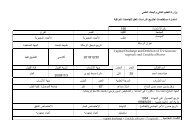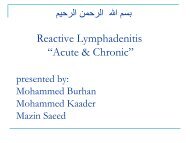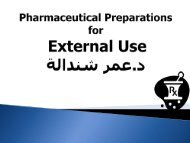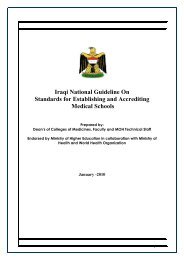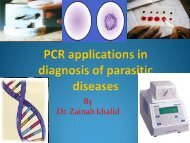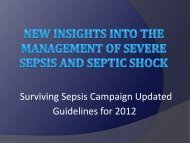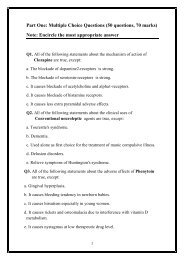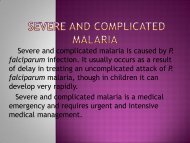Volume 35 June 2009 Number 1 - University of Mosul
Volume 35 June 2009 Number 1 - University of Mosul
Volume 35 June 2009 Number 1 - University of Mosul
Create successful ePaper yourself
Turn your PDF publications into a flip-book with our unique Google optimized e-Paper software.
Annals <strong>of</strong> the College <strong>of</strong> Medicine Vol. <strong>35</strong> No. 1, <strong>2009</strong><br />
Table (3): Age distribution <strong>of</strong> women with their total children ever born and average parity<br />
No. <strong>of</strong> children ever born Average<br />
Mother’s age group All women<br />
parity<br />
Male Female Total /mother<br />
15- 48 32 24 56 1.16<br />
20- 298 315 289 604 2.02<br />
25- 228 279 319 598 2.62<br />
30- 140 255 281 536 3.82<br />
<strong>35</strong>- 176 469 4<strong>35</strong> 904 5.13<br />
40- 113 389 <strong>35</strong>5 744 6.58<br />
45-49 43 166 118 284 6.60<br />
Total 1046 1905 1821 3726 Sum<br />
Table (4): Distribution <strong>of</strong> death cases by causes and sex<br />
Causes Male Female Total Percent<br />
Respiratory* problem 59 36 95 26.38<br />
Congenital abnormality 27 29 56 15.55<br />
Fever* 22 27 49 13.6<br />
Premature 15 18 33 9.1<br />
Diarrhea* 15 16 31 8.6<br />
Unknown* 18 12 30 8.3<br />
Others** 36 30 66 18.3<br />
Totals 192 168 360 100%<br />
*These causes are classified under international classification <strong>of</strong> diseases 10 th revision (15,16,17) .<br />
**Others: Include injury, accidents, meningitis, septicemia.<br />
Discussion<br />
Childhood mortality rates are used to<br />
determine the level <strong>of</strong> human and economic<br />
development <strong>of</strong> the country (18,19) . The present<br />
survey indicates that under five mortality rates<br />
is 107/1000 last live birth which represents 2.5<br />
fold rise <strong>of</strong> under five mortality rates estimated<br />
by UNICIF/WHO maternal and child mortality<br />
survey done at 1990 which was 41/1000 live<br />
birth (20 ,21) . The results that were obtained from<br />
the vital registration system show that the<br />
estimated under five mortality for the year<br />
2007 is 24/1000 live birth and the infant<br />
mortality rate is 19.5/1000 live birth that occur<br />
during the year 2007. Another datum that has<br />
been taken from the Statistics Unit <strong>of</strong> Al-<br />
Khannsa Hospital shows more or less similar<br />
results as under five mortality rate was<br />
32/1000 live birth and the IMR was 28.58/1000<br />
live birth. These findings yield that only 20.4 %<br />
<strong>of</strong> all infant mortality which occurred has been<br />
registered and only 22.4 % <strong>of</strong> real under five<br />
mortality has been registered as compared<br />
with the present survey results (22) . Similarly,<br />
almost one third <strong>of</strong> deaths (29.8 %) has been<br />
registered in Al-Khannsa Hospital Statistical<br />
Unit for both infant and under five mortality<br />
when compared with the result <strong>of</strong> the present<br />
survey (23) . This is due to information on deaths<br />
from the health information system,<br />
unfortunately, does not reflect the mortality<br />
picture from population perspective because it<br />
is government facility – based data and thus<br />
does not include deaths that occur outside<br />
such facilities or from private heath institutions<br />
(24) . In many developing countries, vital<br />
registration data are incomplete. The severity<br />
<strong>of</strong> the under-reporting varies from country to<br />
country, and also varies over time within<br />
© <strong>2009</strong> <strong>Mosul</strong> College <strong>of</strong> Medicine 4




